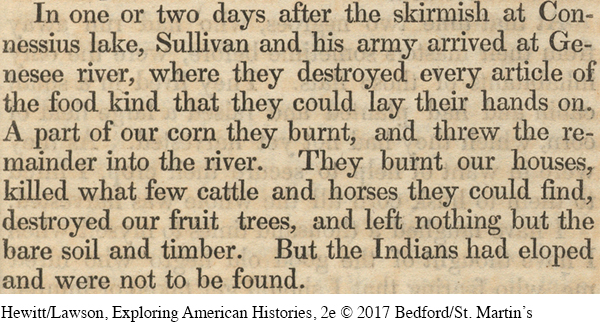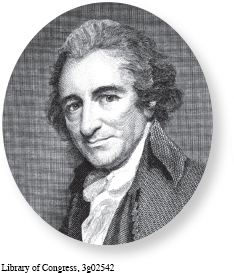Introduction to Chapter 6
6
The American Revolution
1775–1783
WINDOW TO THE PAST
The War’s Impact on the Seneca Nation, 1823
General John Sullivan, with 4,000 patriot troops, sought to end the support that the Seneca and other Iroquois Indians in New York State gave to British troops by destroying their villages in 1779. Mary Jemison, a white woman captured by Indians in 1758, had married a Seneca man and lived with him and their children through the American Revolution. Jemison provided this account of her life to minister James Seaver in 1823. To discover more about what this primary source can show us, see Document 6.4.

LEARNING OBJECTIVES
After reading this chapter you should be able to:
Explain the relationship between the beginning of armed conflict and patriots’ decision to declare independence.
Understand the choices of colonists, American Indians, and African Americans to support or oppose independence.
Analyze the military strategies of the British and the Americans in 1776–1777, the roles that various allies played, and the importance of women and other groups on the home front.
Explain the major accomplishments of and conflicts within the new state and federal governments during the Revolution.
Analyze the shift of warfare to the South and West from 1778 to 1781; the importance of American Indians, foreign allies, and colonial soldiers in patriot victories there; and the challenges Americans faced once they defeated the British.
AMERICAN HISTORIES

One of the foremost pamphleteers of the patriot cause, Thomas Paine was born in 1737 in England, where his parents trained him as a corset maker. Eventually he left home and found work as a seaman, a teacher, and a tax collector. He drank heavily and beat both his wives. Yet he also taught working-class children to read and pushed the British government to improve the working conditions and pay of tax collectors. In 1772 Paine was fired from his government job, but a pamphlet he wrote had caught the eye of Benjamin Franklin, who persuaded him to try his luck in the colonies.
Arriving in Philadelphia in November 1774 at age thirty-seven, Paine secured a job on the Pennsylvania Magazine. The newcomer quickly gained in-depth political knowledge of the intensifying conflicts between the colonies and Great Britain. He also gained patrons for his political tracts among Philadelphia’s economic and political elite. When armed conflict with British troops erupted in April 1775, colonial debates over whether to declare independence intensified. Pamphlets were a popular means of influencing these debates, and Paine wrote one entitled Common Sense to tip the balance in favor of independence.
Published in January 1776, Common Sense proved an instant success. It provided a rationale for independence and an emotional plea for creating a new democratic republic. Paine urged colonists to separate from England and establish a political structure that would ensure liberty and equality for all Americans. “A government of our own is our natural right,” he concluded. “’Tis time to part.”

When Common Sense was published, sixteen-year-old Deborah Sampson was working as an indentured servant to Jeremiah and Susanna Thomas in Marlborough, Massachusetts. Jeremiah Thomas thought education was above the lot of servant girls, but Sampson insisted on reading whatever books she could find. However, her commitment to American independence likely developed less from reading and more from the fighting that raged in Massachusetts and drew male servants and the Thomases’ five sons into the Continental Army.
When Deborah Sampson’s term of service ended in 1778, she sought work as a weaver and then a teacher. In March 1782 she disguised herself as a man and enlisted in the Continental Army. Her height and muscular frame allowed her to fool local recruiters, and she accepted the bounty paid to those who enlisted. But Deborah never reported for duty, and when her charade was discovered, she was forced to return the money.
In May 1782 Sampson enlisted a second time under the name Robert Shurtliff. For the next year, Sampson, disguised as Shurtliff, marched, fought, and lived with her Massachusetts regiment. Her ability to carry off the deception was helped by lax standards of hygiene: Soldiers rarely undressed fully to bathe, and most slept in their uniforms.
Even after the formal end of the war in March 1783, Sampson/
The American histories of Thomas Paine and Deborah Sampson demonstrate how the American Revolution transformed individual lives as well as the life of the nation. Paine had failed financially and personally in England but gained fame in the colonies through his skills as a patriot pamphleteer. Sampson, who was forced into an early independence by her impoverished family, excelled as a soldier. Still, while the American Revolution offered opportunities for some colonists, it promised hardship for others. Most Americans had to choose sides long before it was clear whether the colonists could defeat Great Britain, and the long years of conflict (1775–1783) took a toll on families and communities across the thirteen colonies. Moreover, even with English converts like Paine and homegrown supporters like Sampson, the patriots would need foreign allies to achieve victory. And even battlefield victory could not ensure political stability in the new nation.
Exploring American HistoriesPrinted Page 171
Exploring American Histories Value EditionPrinted Page 128
Chapter Timeline